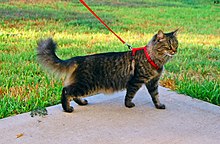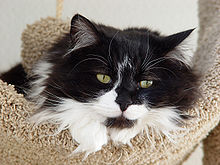Domestic long-haired cat: Difference between revisions
spelling |
Rescuing 4 sources and tagging 0 as dead. #IABot (v1.5.2) |
||
| Line 8: | Line 8: | ||
| note = Like the [[domestic short-haired cat]], this is not a breed, but a non-breed classification of mixed-breed cats. |
| note = Like the [[domestic short-haired cat]], this is not a breed, but a non-breed classification of mixed-breed cats. |
||
}} |
}} |
||
A '''domestic long-haired cat''', or fluffy cat, is a [[cat]] of mixed ancestry – thus not belonging to any particular recognised [[List of cat breeds|cat breed]] – possessing a [[Coat (animal)|coat]] of semi-long to long [[fur]].<ref name="cats101">{{cite video | url=http://animal.discovery.com/tv-shows/cats-101/videos/domestic-longhair.htm | title=Domestic Longhair | publisher=Animal Planet | medium=Video | series=[[Cats 101]]}} Says 10% are long-haired.</ref> Domestic long-haired cats should not be confused with the [[British Longhair]], [[American Longhair]], or other breeds with "Longhair" names, which are [[Cat breed|standardized breeds]] defined by various registries. Domestic long-haireds are the second most popular cat in the [[United States]] after the [[Domestic short-haired cat|domestic short-hair]]ed;<ref name="cats101" /> one in ten of the ninety million cats in the US is a domestic long-hair.<ref name="cats101" /><ref name="AHAFS">{{cite web |url=http://www.americanhumane.org/assets/pdfs/pets-fact-sheet.pdf |title=U.S. Pet (Dog & Cat) Population Factsheet |year=2012 |publisher=American Humane Association (AHA) |accessdate=2013-12-17}} Gives a figure of 95% short-haired.</ref> Other generic terms are '''long-haired house cat''' and, in [[British English]], '''long-haired moggie'''. |
A '''domestic long-haired cat''', or fluffy cat, is a [[cat]] of mixed ancestry – thus not belonging to any particular recognised [[List of cat breeds|cat breed]] – possessing a [[Coat (animal)|coat]] of semi-long to long [[fur]].<ref name="cats101">{{cite video | url=http://animal.discovery.com/tv-shows/cats-101/videos/domestic-longhair.htm | title=Domestic Longhair | publisher=Animal Planet | medium=Video | series=[[Cats 101]]}} Says 10% are long-haired.</ref> Domestic long-haired cats should not be confused with the [[British Longhair]], [[American Longhair]], or other breeds with "Longhair" names, which are [[Cat breed|standardized breeds]] defined by various registries. Domestic long-haireds are the second most popular cat in the [[United States]] after the [[Domestic short-haired cat|domestic short-hair]]ed;<ref name="cats101" /> one in ten of the ninety million cats in the US is a domestic long-hair.<ref name="cats101" /><ref name="AHAFS">{{cite web |url=http://www.americanhumane.org/assets/pdfs/pets-fact-sheet.pdf |title=U.S. Pet (Dog & Cat) Population Factsheet |year=2012 |publisher=American Humane Association (AHA) |accessdate=2013-12-17 |deadurl=yes |archiveurl=https://web.archive.org/web/20130903060111/http://www.americanhumane.org/assets/pdfs/pets-fact-sheet.pdf |archivedate=2013-09-03 |df= }} Gives a figure of 95% short-haired.</ref> Other generic terms are '''long-haired house cat''' and, in [[British English]], '''long-haired moggie'''. |
||
In the [[cat fancy]], and among [[veterinarian]]s and [[Animal control officer|animal control]] agencies, domestic long-haired cats may be classified with organisation-specific terminology (often capitalized), such as '''Domestic Longhair''' ('''DLH'''),<ref name="cats101" /> '''House Cat, Longhair''' ('''HCL'''),<ref name="FIFe1">{{cite web|url=http://fifeweb.org/wp/breeds/breeds_prf_stn.php |title=Breed Standards |author= |year=2013 |work=FIFeWeb.org |publisher=[[Fédération Internationale Féline]] (FIFe) |location=Luxembourg |accessdate=4 March 2013 |archivedate=4 March 2013 |archiveurl= |
In the [[cat fancy]], and among [[veterinarian]]s and [[Animal control officer|animal control]] agencies, domestic long-haired cats may be classified with organisation-specific terminology (often capitalized), such as '''Domestic Longhair''' ('''DLH'''),<ref name="cats101" /> '''House Cat, Longhair''' ('''HCL'''),<ref name="FIFe1">{{cite web |url=http://fifeweb.org/wp/breeds/breeds_prf_stn.php |title=Breed Standards |author= |year=2013 |work=FIFeWeb.org |publisher=[[Fédération Internationale Féline]] (FIFe) |location=Luxembourg |accessdate=4 March 2013 |archivedate=4 March 2013 |archiveurl=https://www.webcitation.org/6ErvWYADX?url=http://fifeweb.org/wp/breeds/breeds_prf_stn.php |deadurl=yes |df= }}</ref><ref name="FIFe2">{{cite web |url=http://www1.fifeweb.org/dnld/std/HCL-HCS.pdf |title=House Cat / Hauskatze / Chat de Maison |author= |date=1 January 2013 |format=[[Portable Document Format|PDF]] |publisher=FIFe |accessdate=4 March 2013 |archivedate=4 March 2013 |archiveurl=https://www.webcitation.org/6ErpzKDwb?url=http://www1.fifeweb.org/dnld/std/HCL-HCS.pdf |deadurl=yes |df= }}</ref> or '''Semi-Longhair Household Pet'''.<ref name="WCF">{{cite web |url=http://www.wcf-online.de/WCF-EN/standard/semi-longhair/hauskatze.html |title=Semi-longhair: Household Pet |author= |date=1 January 2010 |work=WCF-Online.de |publisher=World Cat Federation (WCF) |location=Essen, Germany |accessdate=4 March 2013 |archivedate=4 March 2013 |archiveurl=https://www.webcitation.org/6Erwim513?url=http://www.wcf-online.de/WCF-EN/standard/semi-longhair/hauskatze.html |deadurl=yes |df= }} [[Portable Document Format|PDF]] version: http://www.wcf-online.de/WCF-EN/library/HHP_en_2010-01-01.pdf</ref> Such a pseudo-breed is used for registry and [[Animal shelter|shelter]]/[[Animal rescue group|rescue]] classification purposes. While not bred as [[show cat]]s, some mixed-breed cats are actually [[Pedigreed cat|pedigreed]] and entered into [[cat show]]s that have non-purebred "Household Pet" divisions. Show rules vary, and may permit "any eye colour, all coat colours and patterns, any coat length or texture, and any length of tail"<ref name="FIFe2" /> (i.e., anything at all, as long as the cat is well-proportioned and healthy) or may be more restrictive, e.g.: "The colours chocolate and cinnamon, as well as their dilution (lilac and fawn) are not recognized in any combinations...[and t]he pointed pattern is also not recognized".<ref name="WCF" /> |
||
[[File:Tuxedo longhair cat - Spanky.jpg|thumbnail|left|This domestic long-haired cat appears to be of partial [[Persian (cat)|Persian]] ancestry, with a relatively flat nose and fine hair.]] |
[[File:Tuxedo longhair cat - Spanky.jpg|thumbnail|left|This domestic long-haired cat appears to be of partial [[Persian (cat)|Persian]] ancestry, with a relatively flat nose and fine hair.]] |
||
Revision as of 06:10, 12 September 2017
| Domestic long-haired cat | |
|---|---|
 A brown mackerel tabby domestic long-haired cat | |
| Other names | Domestic Longhair (DLH) House Cat, Longhair (HCL) Longhair Household Pet |
| Common nicknames | Long-haired moggie |
| Variety status | Not recognised as a standardised breed by any major breed registry. |
| Notes | |
Like the domestic short-haired cat, this is not a breed, but a non-breed classification of mixed-breed cats. | |
| Domestic cat (Felis catus) | |
A domestic long-haired cat, or fluffy cat, is a cat of mixed ancestry – thus not belonging to any particular recognised cat breed – possessing a coat of semi-long to long fur.[1] Domestic long-haired cats should not be confused with the British Longhair, American Longhair, or other breeds with "Longhair" names, which are standardized breeds defined by various registries. Domestic long-haireds are the second most popular cat in the United States after the domestic short-haired;[1] one in ten of the ninety million cats in the US is a domestic long-hair.[1][2] Other generic terms are long-haired house cat and, in British English, long-haired moggie.
In the cat fancy, and among veterinarians and animal control agencies, domestic long-haired cats may be classified with organisation-specific terminology (often capitalized), such as Domestic Longhair (DLH),[1] House Cat, Longhair (HCL),[3][4] or Semi-Longhair Household Pet.[5] Such a pseudo-breed is used for registry and shelter/rescue classification purposes. While not bred as show cats, some mixed-breed cats are actually pedigreed and entered into cat shows that have non-purebred "Household Pet" divisions. Show rules vary, and may permit "any eye colour, all coat colours and patterns, any coat length or texture, and any length of tail"[4] (i.e., anything at all, as long as the cat is well-proportioned and healthy) or may be more restrictive, e.g.: "The colours chocolate and cinnamon, as well as their dilution (lilac and fawn) are not recognized in any combinations...[and t]he pointed pattern is also not recognized".[5]

Domestic long-haireds come in all genetically possible cat colours including tabby, tortoiseshell, bi-coloured, and smoke.[1] Domestic long-haireds can have fur that is up to six inches long.[1] They can also have a mane similar to a Maine Coon's, as well as toe tufts and ear tufts.[1] Some long-haired cats are not able to maintain their own coat, which must be frequently groomed by a human or may be prone to matting.[1] Because of their wide gene pool, domestic long-haireds are not predisposed to any genetically inherited problems.[1]
History
This section's factual accuracy is disputed. (February 2015) |
The domestic long-haired cat has been admired around the world for several centuries, particularly for its elegant looks and rugged nature. During the 16th century, the crusaders returning from the Holy Wars, having already brought back plague and pestilence from the East, also imported the first long-haired cats into Europe. In the mid-17th century, as the plague destroyed much of London's population, the cat made its first strides of recovery from centuries of persecution. Despite having been outlawed by the Roman Catholic church, during this time cats were encouraged as protectors from flea-carrying rats.[6]
How they developed in the first place is still a matter of speculation. The long coat may have been the result of a recessive mutant gene. When a long-haired cat is mated to one with a short coat, only short-haired kittens can result; however, their offspring when mated, can produce a proportion of long-coated kittens. Successive litters of early European long-haired cats produced more and more long-coated offspring, which were more likely to survive in the cooler European climates. By the year 1521, around the time they were first documented in Italy, the variety had become fixed after only a few generations.[7]
In the late 18th century, Peter Simon Pallas had advanced the hypothesis that the manul (also known as Pallas's cat) might be the ancestor of the long haired domestic cat.[7] He had anecdotal evidence that established even though the male offspring would be sterile hybrids, the female offspring could again reproduce with domestic cats and pass on a small proportion of the manul's genes.[8] In 1907, zoologist Reginald Innes Pocock refuted this claim, citing his work on the skull differences between the manul and the Angoras or Persians of his time.[8] This early hypothesis overlooked the potential for cross breeding within the family Felidae. For example, the Savannah Cat is a cross-breed between a DSH-Bengel and a wild African Serval—both of which have different skulls and evolutionary lineage. Furthermore, hybrid females in the related Panthera genus, such as ligers and tigons, have successfully mated in many documented cases, producing liligers and titigons.
The first modern, formal breeds of long-haired cats were the Persian and the Angora (after Ankara, Turkey) and were said to have come from those two areas.[6]
See also
References
- ^ a b c d e f g h i Domestic Longhair (Video). Cats 101. Animal Planet. Says 10% are long-haired.
- ^ "U.S. Pet (Dog & Cat) Population Factsheet" (PDF). American Humane Association (AHA). 2012. Archived from the original (PDF) on 2013-09-03. Retrieved 2013-12-17.
{{cite web}}: Unknown parameter|deadurl=ignored (|url-status=suggested) (help) Gives a figure of 95% short-haired. - ^ "Breed Standards". FIFeWeb.org. Luxembourg: Fédération Internationale Féline (FIFe). 2013. Archived from the original on 4 March 2013. Retrieved 4 March 2013.
{{cite web}}: Unknown parameter|deadurl=ignored (|url-status=suggested) (help) - ^ a b "House Cat / Hauskatze / Chat de Maison" (PDF). FIFe. 1 January 2013. Archived from the original (PDF) on 4 March 2013. Retrieved 4 March 2013.
{{cite web}}: Unknown parameter|deadurl=ignored (|url-status=suggested) (help) - ^ a b "Semi-longhair: Household Pet". WCF-Online.de. Essen, Germany: World Cat Federation (WCF). 1 January 2010. Archived from the original on 4 March 2013. Retrieved 4 March 2013.
{{cite web}}: Unknown parameter|deadurl=ignored (|url-status=suggested) (help) PDF version: http://www.wcf-online.de/WCF-EN/library/HHP_en_2010-01-01.pdf - ^ a b Sayer, Angela. World Encyclopedia of Cats. Secaucus, New Jersey: Chartwell Books. pp. 40–41.
- ^ a b "Domestic Cat × Pallas's Cat". Macro Evolution. Retrieved 2014-06-02.
- ^ a b Sarah Hartwell (2013). "Long Haired Cats". Messy Beast. Retrieved 2014-06-02.
